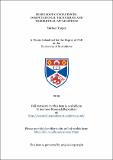Files in this item
Semigroup congruences : computational techniques and theoretical applications
Item metadata
| dc.contributor.advisor | Mitchell, James David | |
| dc.contributor.author | Torpey, Michael | |
| dc.coverage.spatial | 194 p. | en_US |
| dc.date.accessioned | 2019-03-22T15:02:32Z | |
| dc.date.available | 2019-03-22T15:02:32Z | |
| dc.date.issued | 2019-06-25 | |
| dc.identifier.uri | https://hdl.handle.net/10023/17350 | |
| dc.description.abstract | Computational semigroup theory is an area of research that is subject to growing interest. The development of semigroup algorithms allows for new theoretical results to be discovered, which in turn informs the creation of yet more algorithms. Groups have benefitted from this cycle since before the invention of electronic computers, and the popularity of computational group theory has resulted in a rich and detailed literature. Computational semigroup theory is a less developed field, but recent work has resulted in a variety of algorithms, and some important pieces of software such as the Semigroups package for GAP. Congruences are an important part of semigroup theory. A semigroup’s congruences determine its homomorphic images in a manner analogous to a group’s normal subgroups. Prior to the work described here, there existed few practical algorithms for computing with semigroup congruences. However, a number of results about alternative representations for congruences, as well as existing algorithms that can be borrowed from group theory, make congruences a fertile area for improvement. In this thesis, we first consider computational techniques that can be applied to the study of congruences, and then present some results that have been produced or precipitated by applying these techniques to interesting examples. After some preliminary theory, we present a new parallel approach to computing with congruences specified by generating pairs. We then consider alternative ways of representing a congruence, using intermediate objects such as linked triples. We also present an algorithm for computing the entire congruence lattice of a finite semigroup. In the second part of the thesis, we classify the congruences of several monoids of bipartitions, as well as the principal factors of several monoids of partial transformations. Finally, we consider how many congruences a finite semigroup can have, and examine those on semigroups with up to seven elements. | en_US |
| dc.language.iso | en | en_US |
| dc.publisher | University of St Andrews | |
| dc.subject | Semigroups | en_US |
| dc.subject | Computational algebra | en_US |
| dc.subject | Computational mathematics | en_US |
| dc.subject | Congruences | en_US |
| dc.subject | Algorithms | en_US |
| dc.subject | Diagram semigroups | en_US |
| dc.subject | Bipartitions | en_US |
| dc.subject | Bipartition semigroups | en_US |
| dc.subject | Partition semigroups | en_US |
| dc.subject | Motzkin monoid | en_US |
| dc.subject | Finite semigroups | en_US |
| dc.subject | Finitely presented semigroups | en_US |
| dc.subject | Simple semigroups | en_US |
| dc.subject | 0-simple semigroups | en_US |
| dc.subject | Inverse semigroups | en_US |
| dc.subject.lcc | QA182.T7 | |
| dc.subject.lcsh | Semigroups--Data processing | en |
| dc.subject.lcsh | Algorithms | en |
| dc.title | Semigroup congruences : computational techniques and theoretical applications | en_US |
| dc.type | Thesis | en_US |
| dc.contributor.sponsor | Engineering and Physical Sciences Research Council (EPSRC) | en_US |
| dc.type.qualificationlevel | Doctoral | en_US |
| dc.type.qualificationname | PhD Doctor of Philosophy | en_US |
| dc.publisher.institution | The University of St Andrews | en_US |
| dc.identifier.doi | https://doi.org/10.17630/10023-17350 |
This item appears in the following Collection(s)
Items in the St Andrews Research Repository are protected by copyright, with all rights reserved, unless otherwise indicated.

